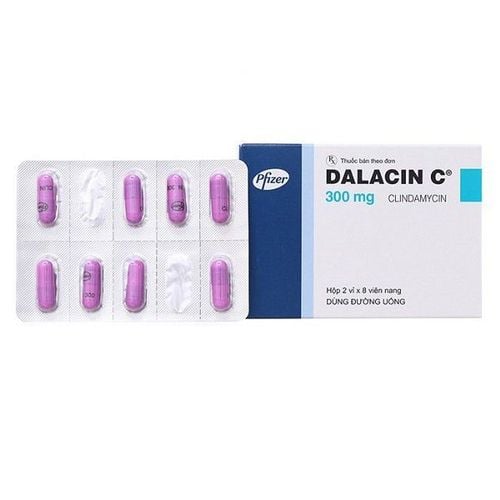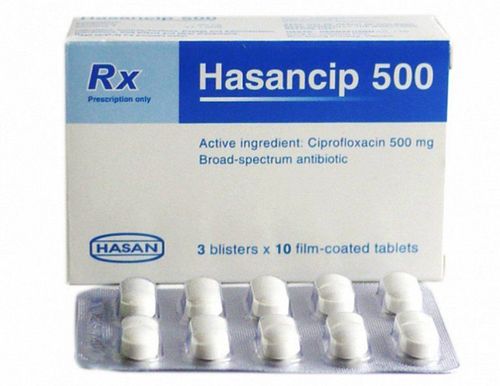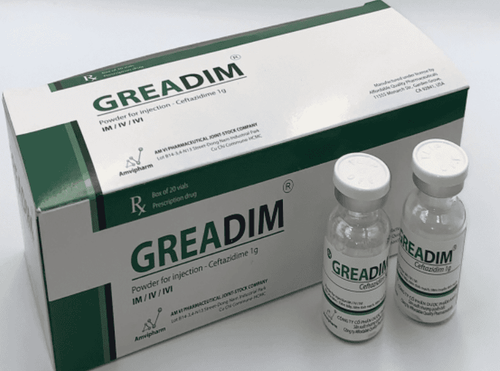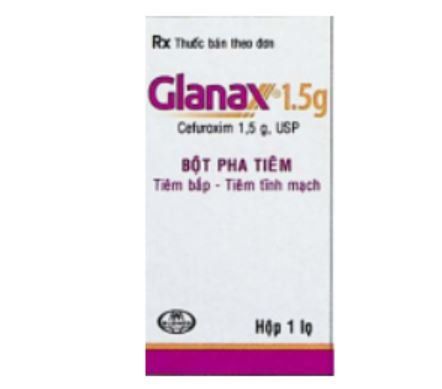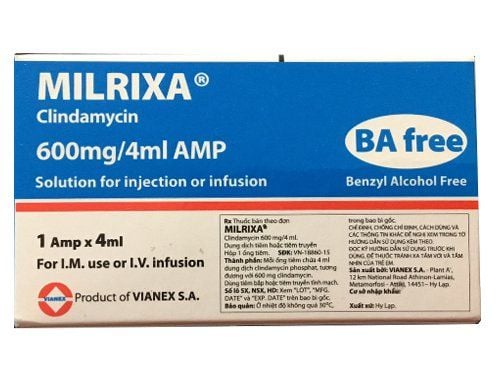This is an automatically translated article.
Macxicin drug is prepared in the form of powder for solution for injection, the main ingredient is Ceftazidim. The drug is used in the treatment of certain diseases caused by bacteria that are sensitive to the drug.
1. What is the drug?
One box of Macxicin contains:
1 vial containing a sterile mixture of Ceftazidime and sodium carbonate equivalent to 2g of Ceftazidim; 1 ampoule of distilled water for injection contains 5ml of sterile water for injection. Ceftazidime is a broad-spectrum, semi-synthetic beta-lactam antibiotic and is administered parenterally. Ceftazidime is a 3rd generation cephalosporin antibiotic, which has bactericidal action by inhibiting the enzyme that synthesizes bacterial cell membranes. Many gram-negative organisms are susceptible to ceftazidime, including those resistant to gentamycin and some other aminoglycosides. Besides, Ceftazidim is also active against gram-positive bacteria. At the same time, the drug is also active against many strains of bacteria resistant to ampicillin and other cephalosporins.
Indications for the use of Macxicin: Treatment in patients with infections caused by susceptible strains of bacteria in the following diseases:
Lower respiratory tract infections; Skin and skin structure infections; Complicated/uncomplicated urinary tract infections; Blood infection ; Bone and joint infections; Gynecological infections: Including endometritis, genital infections, pelvic cellulitis; Intra-abdominal infections: Including peritonitis and multiple infections; Central nervous system infections, including meningitis. Ceftazidime may be used alone in cases of suspected or confirmed sepsis. The drug has been successfully used in clinical trials using multiple antibiotics simultaneously. Ceftazidime can be used concurrently with other antibiotics such as aminoglycoside antibiotics, clindamycin, vancomycin in severe life-threatening infections or in immunocompromised patients. Dosage will be customized according to the severity of the infection and the patient's condition.
To reduce the development of drug-resistant bacteria and maintain the effectiveness of Ceftazidime or other antibacterial agents, use Ceftazidime only to treat or prevent infections that have been determined to be caused by bacteria. sensitive. Once information on bacterial culture and susceptibility is available, appropriate treatment options should be considered.
Contraindications to the use of Macxicin:
Patients with hypersensitivity to drugs or antibiotics of the Cephalosporin group.
2. How to use and dose of the drug Macxicin
2.1. How to use Macxicin Drugs Macxicin is used intravenously or deep intramuscular injection. Patients are usually injected into the upper quadrant of the buttocks or into the lateral part of the thigh.
How to mix and specify the types of solutions for infusion:
Intramuscular: For intramuscular injection, Ceftazidim should be mixed with one of the following solvents: Bacteriostatic water for injection, sterile water for injection or Lidocaine Hydrochloride injection. 0.5% and 1%; Intravenous injection: Intravenous injection is often used in patients with meningitis, bacteremia, peritonitis, or other very serious, life-threatening infections. In addition, intravenous injection is also indicated for patients at risk of serious complications due to low resistance because of depression such as malnutrition, surgery, trauma, diabetes, heart failure, malignant tumors. count; Intravenous infusion: Mix 1g or 2g vial with 100ml of sterile water for injection or 0.9% sodium chloride or 5% dextrose solution. Alternatively, the powder can be dissolved in a 500mg, 1g or 2g vial and then add the appropriate amount of solution to the container of one of the compatible intravenous solutions. 2.2. Dosage of Macxicin The dose of Macxicin depends on the severity, location, susceptibility, type of infection, weight, age and renal function of the patient. In most infections: 1g every 8 hours or 1g every 12 hours. In very severe infections: 2g every 12 hours.
Specific:
Adults: Use dose 1 - 6g/day, divided into 2 - 3 times; Children from 1 month to 12 years old: 30 - 50mg/kg body weight every 8 hours; Neonates up to 1 month: 30 mg/kg body weight every 12 hours; Elderly: The usual dose should not exceed 3g/day, especially in patients over 70 years of age; Patients with impaired renal function: Ceftazidime is eliminated by the kidneys (primarily by glomerular filtration), so in patients with renal impairment (renal failure rate less than 50 ml/min) the dose of ceftazidime should be reduced to compensate for the loss of renal function. its slow discharge. In patients with suspected renal insufficiency, a loading dose of 1 g of Ceftazidime may be used. At the same time, the patient's glomerular filtration rate should be checked to determine an appropriate maintenance dose. The recommended dose for patients with renal failure is as follows: Creatinine clearance 31 - 50ml/min: Dose 1g/time every 12 hours; Creatinine clearance 16 - 30ml/min: Dose 1g/time every 24 hours; Creatinine clearance 6 - 15ml/min: Dose 500mg/time every 24 hours; Creatinine clearance less than 5ml/min: 500mg once every 48 hours. Overdose: Ceftazidime overdose is common in patients with renal impairment. Reactions include encephalopathy, tremors, convulsions, increased neuromuscular excitability, and coma. Patients with acute overdose should be carefully monitored and given supportive treatment. In the case of patients with renal insufficiency, hemodialysis or peritoneal dialysis can be used to remove Ceftazidime from the body.
3. Macxicin side effects
Generally, Ceftazidime is well tolerated, the incidence of adverse reactions is quite low. When using Macxicin, patients may experience some side effects such as:
Local reactions: Phlebitis and inflammation at the injection site; Hypersensitivity reactions: Pruritus, rash, fever, toxic skin necrosis, erythema multiforme, Stevens-Johnson syndrome, angioedema, anaphylaxis (bronchospasm, hypotension); Gastrointestinal symptoms: Diarrhea, nausea, vomiting, abdominal pain, pseudomembranous enterocolitis (appearing during or after treatment); Central nervous system reactions: Dizziness, headache, paresthesia, convulsions, encephalopathy, tremor, coma, increased neuromuscular excitability; Hematology: Hemolytic anemia; Laboratory changes: Eosinophilia/platelets; positive Coombs test without hemolysis; mild elevation of some liver enzymes such as AST, ALT, LDH, GGT and alkaline phosphatase; temporary increase in blood urea/blood urea nitrogen/serum creatinine/lymphocytes; decreased neutrophils/white blood cells/platelets; agranulocytosis. Other reactions: Candida disease (including thrush), vaginitis . Patients should inform their doctor about the side effects encountered when using Macxicin to receive advice on appropriate handling.
4. Be careful when using the drug Macxicin
Before and during taking Macxicin, the patient should note:
Before starting treatment with Ceftazidime, it is necessary to determine if the patient has had a hypersensitivity reaction to Ceftazidime, Cephalosporin, Penicillin or other drugs. If the drug is used in penicillin-sensitive patients, caution should be exercised because of the risk of cross-sensitization between beta-lactams and ceftazidime (in 10% of patients with a history of penicillin allergy). If an allergic reaction to Ceftazidime occurs, it should be discontinued immediately. When patients experience severe hypersensitivity reactions to Ceftazidime, epinephrine or other emergency drugs such as oxygen, intravenous fluids, intravenous antihistamines, corticosteroids, vasoconstricting amines, and ventilation should be administered as clinically indicated. ; There have been cases of ceftazidime use with pseudomembranous colitis ranging from mild to life-threatening. Therefore, the diagnosis should be considered for patients with diarrhea after taking Macxicin; Treatment with antibacterial drugs in general, and Ceftazidim in particular, change the normal flora in the intestinal tract, causing overgrowth of Clostridium difficile - the main cause of antibiotic-associated enteritis; Once diagnosed with pseudomembranous enterocolitis, the patient should receive appropriate treatment. Mild cases of pseudomembranous enterocolitis usually respond with discontinuation of the drug. In moderate to severe cases, supplementation with electrolytes, water, and protein and combination therapy with clinically effective antibiotics is recommended for Clostridium difficile enteritis; Increased plasma concentrations of Ceftazidime in patients with renal impairment may lead to convulsions, tremors, encephalopathy, coma, and increased neuromuscular excitability. The total daily dose should be reduced if used in patients with renal impairment. The dose of the drug should be continued only if the degree of renal failure, the degree of infection, the susceptibility of the bacteria has been determined; Prolonged use of Ceftazidime may result in overgrowth of bacteria that are not susceptible to the drug. The patient's condition should be re-evaluated, if superinfection occurs during treatment, appropriate measures should be taken; Resistance to b - lactamase type 1 has been recorded in some bacterial strains (Pseudomonas spp, Enterobacter spp, Serratia spp,...) when using Ceftazidim. Resistance can develop during treatment, leading to failure in some cases. When treating infections caused by these organisms, clinical susceptibility testing should be performed periodically. If the patient does not respond to monotherapy, additional aminoglycoside antibiotics or a similar antibiotic may be considered; Ceftazidime may lead to a decrease in prothrombin activity. High-risk cases include patients with liver failure, kidney failure, poor nutrition, people who are taking a long course of antibiotics. Prothrombin time should be controlled in at-risk patients, adding vitamin K if necessary; Ceftazidim should be used with caution in patients with a history of gastrointestinal disease, especially colitis; There is a risk of distal tubular necrosis when ceftazidime is injected into the artery; Patients should be reminded that the antibiotic Ceftazidime is only used to treat bacterial infections, not viral infections. Although at the beginning of treatment, patients will find the drug to be quite effective, but it is necessary to use the right dose and the right dose. If the dose is missed or the drug is not used for a long time according to the course, it may reduce the effectiveness of the treatment, increase the possibility of resistant bacteria leading to the drug Ceftazidim may no longer work in the future; Use of Ceftazidim may cause a false-positive reaction for glucose in the urine if Benedict, Fehling's solution or Clinitest tablets are used; Animal studies have shown that Ceftazidime does not affect fertility or fetal health. However, there are no adequate studies in pregnant women, so Macxicin should be used during pregnancy only when clearly needed; Ceftazidime is excreted in breast milk, so caution should be exercised when using Macxicin in lactating women; Macxicin drugs can cause headaches, convulsions, dizziness, paresthesias, ... so be careful when driving, operating machinery, ...
5. Macxicin drug interactions
Drug interactions can affect the action of the drug, the effectiveness of the treatment or increase the side effects. Therefore, it is important that patients know not to start taking a new medication, stop taking it, or change the dose of any medication without their doctor's consent. At the same time, the patient should share with the doctor about the drugs he is taking / recently taking, his medical history to have the most appropriate adjustment.
Some drug interactions of Macxicin include:
When cephalosporins (including Ceftazidime) are co-administered with aminoglycosides and potent diuretics such as furosemide, nephrotoxicity may occur. Careful monitoring of function is recommended, especially during high-dose or prolonged use of aminoglycosides (due to the nephrotoxic and ototoxic effects of aminoglycosides). When Ceftazidime was used alone in clinical trials, no nephrotoxicity and ototoxicity were observed; Chloramphenicol is antagonistic to beta-lactam antibiotics such as Ceftazidime. Because of the potential for antagonism, especially when bactericidal action is required, this combination should be avoided. When prescribed to use Macxicin, patients should strictly follow the detailed instructions of the treating doctor. This will help ensure the effectiveness of the bactericidal treatment, reduce the risk of future drug resistance, and limit the possibility of dangerous side effects.
Please dial HOTLINE for more information or register for an appointment HERE. Download MyVinmec app to make appointments faster and to manage your bookings easily.




